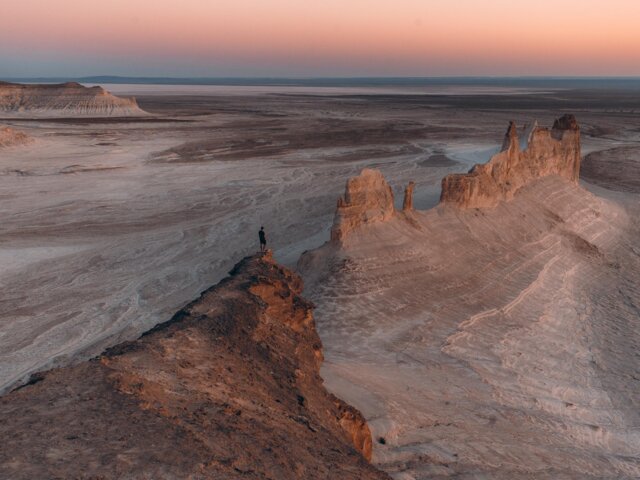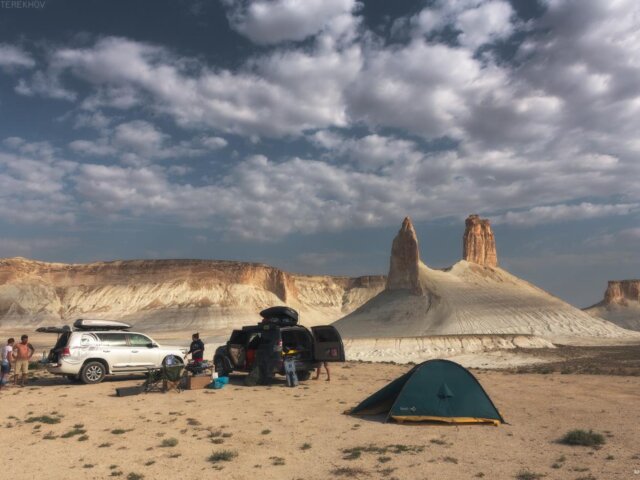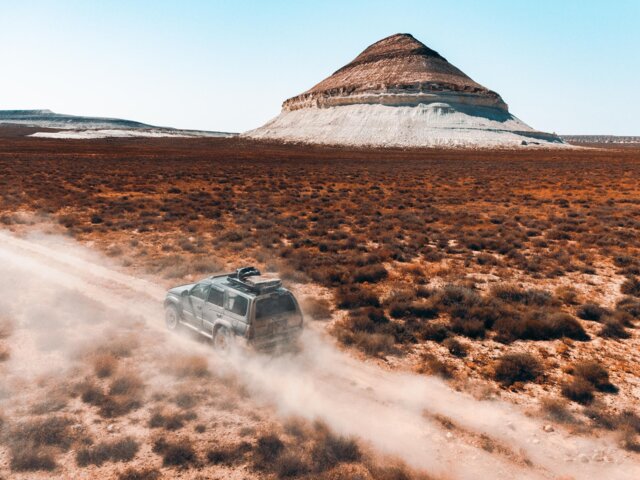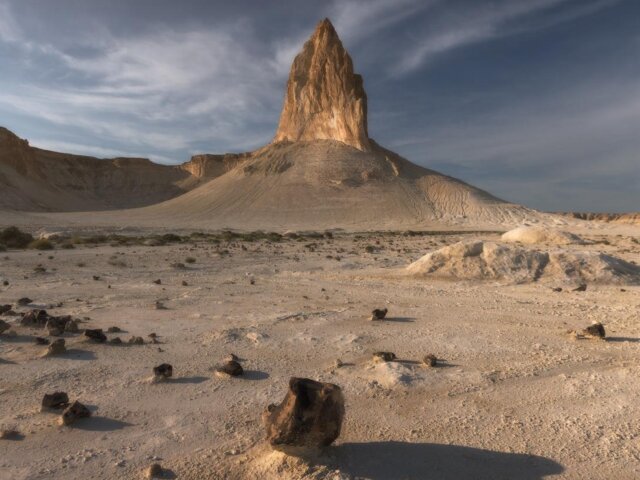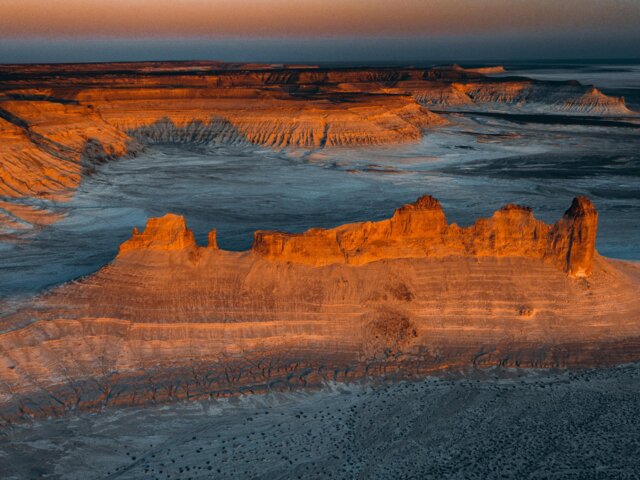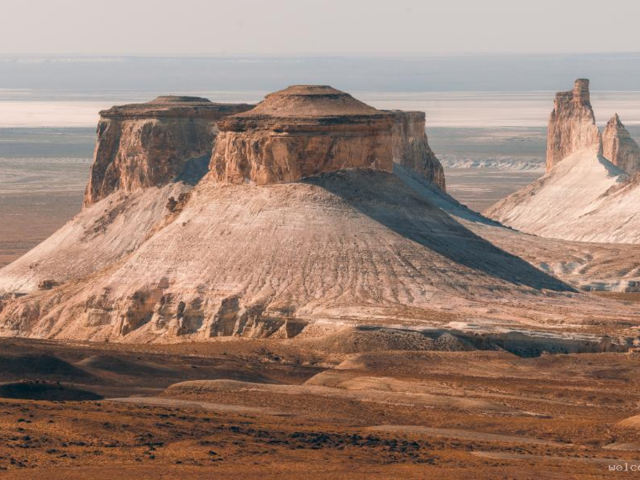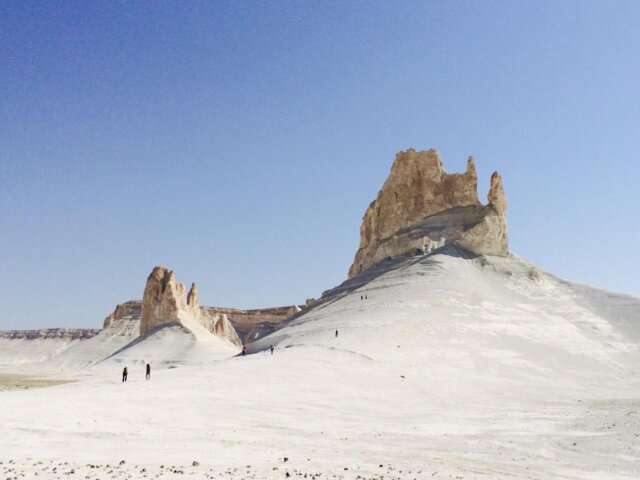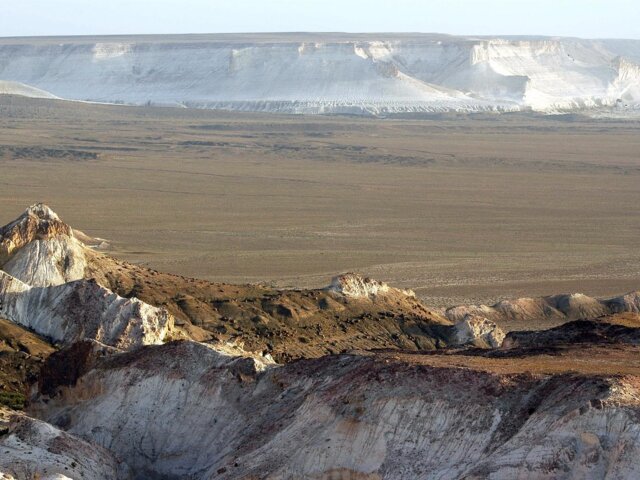Bosjira Tract
Bosjira (also spelled as Bozjyra or Boszhira) is a mountain range that never fails to fascinate tourists. Its white fang-like buttes are what draw visitors to this amazing place. Some people notice that the tract’s lunar-like terrain looks similar to the Monument Valley in Utah, USA.
How was it formed?
The tract was once the bottom of the ancient Tethys Ocean, which covered most of modern-day Eurasia. Presumably, the Tethys dried up more than 5 million years ago. The Caspian Sea, the Mediterranean Sea, and the Black Sea are thought to be remnants of the Tethys Ocean. Admiring the tract’s surreal landscapes, don’t forget to look under your feet – you will likely find fossilized algae, shells, or teeth of ancient sharks. In later eras, the tract was home to hipparions (extinct horses) and saber-toothed tigers. Leopards and cheetahs are also said to have lived there.
“Bosjira” is a Kazakh word meaning “a faded colored valley” or “a gray land”. The tract lives up to its name, as its white buttes are formed by sandstone and chalk. In ancient times, there were more buttes. Over time, they were destroyed by erosion and weathering. The landscape is still changing. Research shows that in about 5000 years Bosjira will change beyond recognition.
Two buttes towering over the entrance to the tract are called “fangs” or “azu tisteri” in Kazakh. The “fangs” stand at 200 meters (656 ft) each. Visitors often set up camps at the foot of these buttes. Also, there you can see mountains that resemble a yurt, a spire, and a submarine. Some of the tract’s buttes are even depicted on a 1000 tenge banknote.
Climate and wildlife
Only the most unpretentious and hardy species can live in the climate of Bosjira. It is extremely hot in summer and the soil is rich in salts. However, some plants and animals still thrive in this area.
The most beautiful plant in Bosjira is a special kind of hyacinth that blooms on rocky soil. You can also find acacias and cockspur grass. Also, there are many lizards, scorpions, and turtles.
The weather changes rapidly. From autumn to mid-spring, it often rains and the water washes out the roads. Those stuck in the tract can wait for help for several days, so you should be extremely careful. We strongly recommend you set off for a trip only in dry weather. Summer is the safest time to travel.
In summer, it is very hot in the area. The temperature is much higher than in nearby cities. However, at night the temperature drops, so you need to have warm clothes if you plan to camp on the tract.
Bosjira is probably one of the best places in the world to watch dawns and sunsets. Seeing such a visually spectacular sight is definitely worth your bucket list.

Location
Bosjira Tract is located in the western part of the Ustyurt Plateau. It is part of the Ustyurt Nature Reserve, which was founded in 1984 to preserve rare plant and animal species.
Be ready to walk a lot as SUVs can’t reach some areas. Be sure to wear comfortable clothes and shoes. Mind your step – the rocks may be dangerous.
Beket Ata Underground Mosque, the region’s main Muslim shrine, is located 20 km (12.4 mi) away from the tract. Also, on your way to Bosjira, you’ll pass Mount Bokty which looks like a layered cake. It is another natural wonder that is worth checking out.
How to get there?
The nearest large cities to the Bosjira Tract are Aktau and Zhanaozen. You can get to the tract only by off-road vehicles. The distance from Zhanaozen to Bosjira is about 150 km (93 mi); from Aktau to Bosjira – almost 300 km (186 mi).
To reach the tract, you need to drive to Zhanaozen first. Drive through Zhanaozen and after about 20 km (12.4 mi) there will be a fork in the road and a road sign. If you turn left, you’ll reach Beket Ata Underground Mosque. If you turn right, you’ll find yourself in the village of Senek – that’s the right way to the tract. Leave Senek and drive through the valley of Mount Bokty. From Bokty to Bosjira, the road has steep descents and ascents.
Bosjira is as beautiful as it is remote, so the safest way to visit is to book a tour with a travel agency. Not so long ago, the tract was considered a place inaccessible to tourists. Nowadays, travel agencies regularly bring tourists there. The most important thing is to have a good off-road vehicle. Visitors should keep in mind that there are no paved roads and road signs, so it is best to travel with a person who knows the area well.
Other tourist attractions near the Bosjira Tract:
• Ustyurt Plateau
• Ustyurt Nature Reserve
• Karynzharyk Hollow
• Kenderli Salt Pan
• The Town of Zhanaozen
• Shopan Ata Underground Mosque
• Beket Ata Underground Mosque
• Tuyesu Sand Dunes

